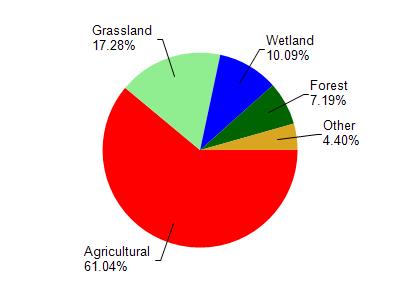Kewaunee
No
No
No
Fish and Aquatic Life
Overview
The Kewaunee River delivers a sediment load of about 1900 tons/year to the Kewaunee Harbor and Lake Michigan. In 1988, the Army Corps of Engineers dredged 41,089 cubic meters of sediment from the harbor. The Corps removed an additional 5,220 cubic meters in 1989. Sediment sampling in 1988 revealed levels of oil and grease, total phosphorus, lead and chemical oxygen considered characteristic of moderately polluted sediments. Total Kjeldahl nitrogen and ammonia levels were indicative of heavily polluted sediments (IJC, 1991). Dredged material was delivered to a confined disposal facility.
In 1978 and 1979, fish flesh screening for toxic chemical contamination found that PCB concentrations exceeded FDA health standards in carp at the river's mouth. There is currently no fish consumption advisory for the Kewaunee River. Complete consumption advisories are stated in the Health Guide for People who eat Sport Fish from Wisconsin Waters. Anglers should examine the guide regularly for possible changes in advisory status. The city of Kewaunee and the village of Luxemburg have wastewater treatment plants that discharge to the Kewaunee River. The Kewaunee treatment plant is operating properly and is not known to be degrading water quality. However, there is potential for the plant to discharge toxic contaminants due to several metal working companies operating in the city. Kewaunee Bottling Co. also discharges to the plant.
WDNR Wastewater Management personnel recommend toxic assessment of the plant's effluent. The Luxemburg wastewater treatment plant has had problems with BOD and suspended solids levels exceeding WPDES permit limits. The village has worked with Packerland Whey Products to monitor and reduce pretreatment influent loadings. The village also removed sludge from its wastewater treatment lagoons. As a result of these activities, the village's discharge is now in compliance. WDNR staff have recommended that a Great Lakes or cold water community classification for water quality standards be applied to the Kewaunee River (Kincaid et al., 1992). Industrial discharges to the river include Kewaunee Equipment and General Housewares, both located in Kewaunee. These industries discharge non-contact cooling water and do not pose water quality threats.
From: Willman, Guy and Mike Toneys. 2001. The State of the Lakeshore Basin. Wisconsin Department of Natural Resources, Madison, WI.
Date 2001
Author Aquatic Biologist
Condition
Wisconsin has over 84,000 miles of streams, 15,000 lakes and milllions of acres of wetlands. Assessing the condition of this vast amount of water is challenging. The state's water monitoring program uses a media-based, cross-program approach to analyze water condition. An updated monitoring strategy (2015-2020) is now available. Compliance with Clean Water Act fishable, swimmable standards are located in the Executive Summary of Water Condition in 2018. See also the 'monitoring and projects' tab.
Management Goals
Wisconsin's Water Quality Standards provide qualitative and quantitative goals for waters that are protective of Fishable, Swimmable conditions [Learn more]. Waters that do not meet water quality standards are considered impaired and restoration actions are planned and carried out until the water is once again fishable and swimmable
Management goals can include creation or implementation of a Total Maximum Daily Load analysis, a Nine Key Element Plan, or other restoration work, education and outreach and more. If specific recommendations exist for this water, they will be displayed below online.
Monitoring
Monitoring the condition of a river, stream, or lake includes gathering physical, chemical, biological, and habitat data. Comprehensive studies often gather all these parameters in great detail, while lighter assessment events will involve sampling physical, chemical and biological data such as macroinvertebrates. Aquatic macroinvertebrates and fish communities integrate watershed or catchment condition, providing great insight into overall ecosystem health. Chemical and habitat parameters tell researchers more about human induced problems including contaminated runoff, point source dischargers, or habitat issues that foster or limit the potential of aquatic communities to thrive in a given area. Wisconsin's Water Monitoring Strategy was recenty updated.
Grants and Management Projects
| Project Name (Click for Details) | Year Started |
|---|
|
|
Monitoring Projects
| WBIC | Official Waterbody Name | Station ID | Station Name | Earliest Fieldwork Date | Latest Fieldwork Date | View Station | View Data |
|---|
| 20 | Lake Michigan | 10058204 | Kewaunee River | 7/19/2023 | 9/26/2025 | Map | Data |
| 90700 | Kewaunee River | 10058204 | Kewaunee River | 7/19/2023 | 9/26/2025 | Map | Data |
|

Watershed Characteristics
Kewaunee Harbor is located in the Kewaunee River watershed which is 142.12 mi². Land use in the watershed is primarily agricultural (61.10%), grassland (17.30%) and a mix of wetland (10.10%) and other uses (11.60%). This watershed has 292.03 stream miles, 540.90 lake acres and 7,312.87 wetland acres.
Nonpoint Source Characteristics
This watershed is ranked High for runoff impacts on streams, Not Ranked for runoff impacts on lakes and High for runoff impacts on groundwater and therefore has an overall rank of High. This value can be used in ranking the watershed or individual waterbodies for grant funding under state and county programs.However, all waters are affected by diffuse pollutant sources regardless of initial water quality. Applications for specific runoff projects under state or county grant programs may be pursued. For more information, go to surface water program grants.